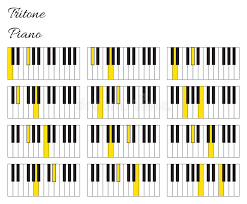Formation of tritones (in depth) First Lesson
Let's touch the ditone voicing of chords, but before that, let's try to understand why these voicings are overly in use now in western music, especially Jazz and Gospels.
First, let's consider the basics. A chord is formed when two or more notes are played either together or in succession. When played at the same time [i.e. together], they are said to be blocked, and when played one note after another [i.e. in succession], they are said to be broken or arpeggriated.
These notes are separated by gaps known as intervals, some of which are consonant and some dissonant. These intervals are what make up the Harmony we hear in a chord. That's why notes played in succession are said to have melodic intervals and those played together are said to have harmonic intervals.
These harmonies created by the note intervals are grouped into various classes based on the value of the intervals.
Harmonies are classed as secundal, tertial, quartal, quintal, etc, based on the intervals they exhibit.
Secundal Harmony is based on notes having a kind of 2nd interval spacing between them. That means we could have a major 2nd or a minor 2nd interval. Chords that have their notes built on this harmony are called Secundal Chords.
Tertial Harmony is based on notes having a kind of 3rd interval spacing between them. That means we could have a major 3rd, a minor 3rd, an augmented 3rd or a diminished 3rd interval. Chords that have their notes built on this harmony are called Tertial Chords. The everyday chords we play are defacto tertial chords - major, minor, augmented, diminished, dominant, etc.
Quartal Harmony is based on notes having a kind of 4th interval spacing between them. That means we could have a perfect 4th, an augmented 4th, or a diminished 4th interval. Chords that have their notes built on this harmony are called Quartal Chords.
Your guess is as good as mine as to what quintal harmony and its chords are.
Quartal Harmony is what tritone and ditone voicings are primarily based upon. Let's see: EbAbC/EBb is C7#5#9 as CEG#BbD# and laid out from left hand to right hand as E.Bb.Eb.Ab.C. E to Bb is an augmented 4th, Bb to Eb is a perfect 4th, Eb to Ab is a perfect 4th and Ab to C is a diminished 4th. We can see all are 4th intervals so that voicing is a quartal voicing.
To be continued…

#pianolessons #chords #scales #piano #chordprogression #inversions #tutorial #music #tritones #jazz #lesson #movement